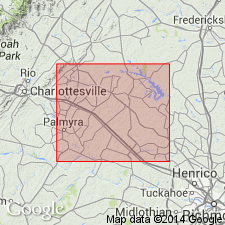
- Usage in publication:
-
- Ellisville granodiorite
- Modifications:
-
- First used
- Dominant lithology:
-
- Granodiorite
- AAPG geologic province:
-
- Piedmont-Blue Ridge province
Summary:
In western Louisa Co., VA, Green Springs diorite and Ellisville granodiorite (both new) were intruded into sedimentary rocks during or immediately following major deformation of probable Mississippian age.
Source: GNU records (USGS DDS-6; Reston GNULEX).

- Usage in publication:
-
- Ellisville biotite granodiorite
- Modifications:
-
- Overview
- AAPG geologic province:
-
- Piedmont-Blue Ridge province
Summary:
Use of term Ellisville biotite granodiorite follows nomenclature of Pavlides (1990: USGS Open-File 90-548). Ellisville intrudes melange zones II and III of the Mine Run complex in central VA. Described as mesocratic, coarse- to medium-grained, equigranular to porphyritic, massive to strongly foliated granodiorite. Predominant minerals are quartz, plagioclase, potassium feldspar, and biotite. Accessories include epidote, allanite, titanite, and apatite. K-feldspar megacrysts up to 1.5 cm across occur in porphyritic rocks. Rb-Sr whole-rock date is 440+/-8 Ma (Pavlides and others, 1982).
Source: GNU records (USGS DDS-6; Reston GNULEX).
For more information, please contact Nancy Stamm, Geologic Names Committee Secretary.
Asterisk (*) indicates published by U.S. Geological Survey authors.
"No current usage" (†) implies that a name has been abandoned or has fallen into disuse. Former usage and, if known, replacement name given in parentheses ( ).
Slash (/) indicates name conflicts with nomenclatural guidelines (CSN, 1933; ACSN, 1961, 1970; NACSN, 1983, 2005, 2021). May be explained within brackets ([ ]).

